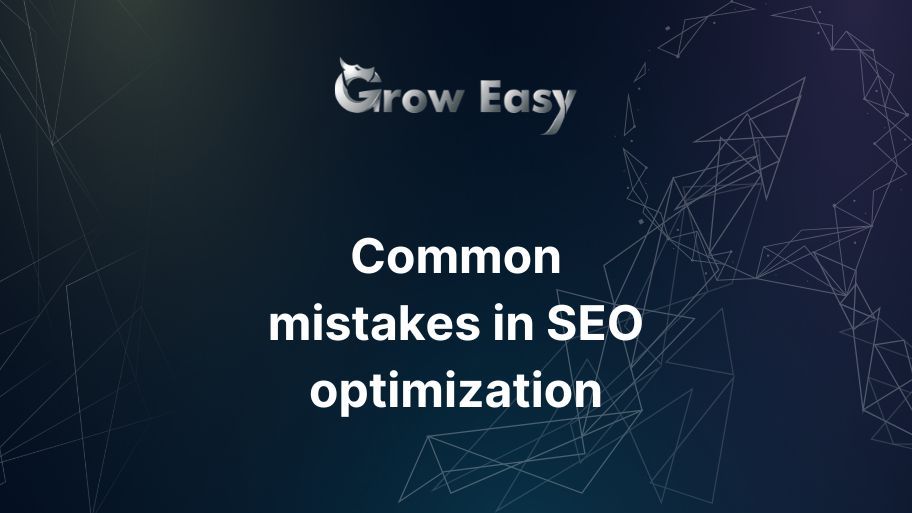In today's article by digital agency “Grow Easy”, we will present some of the most common mistakes in SEO optimization that can sabotage your online presence, and how to avoid them in easy steps.
It's easy to make mistakes when performing search engine optimization for a website. I've even caught myself making silly mistakes here and there. In this situation, it's important for webmasters to know some of the bad things they should do when it comes to SEO.
Sites that don't make mistakes have a better chance against the big players. Sites that have a lot of backlinks but have some issues with their markup can quickly climb the search results when the SEO buttons are fixed. Fortunately for webmasters, most of these mistakes are extremely easy to fix and can be completely corrected in a matter of minutes.

For those whose websites are regularly crawled by search engines, changes can be made by search engines almost instantly. Those with a slightly lower crawl frequency will naturally have to wait longer, but the changes will have their benefits over time. I would also like to add that this article will reflect the changes in SEO in recent years, as meta keywords, for example, are definitely not as important as they once were.
Here are the most common mistakes in SEO optimization and how to fix them:
SEO mistake #1: Nothing to read
The problem:
Either you have filled the entire page with images, OR you are using development methods that are not crawl-friendly, such as a website that uses only Flash. The search engine has no text (or anything else) to read.
You may have a well-written, keyword-rich article that is beautifully rendered in Flash or images, but search engines may not be able to read it. Therefore, you will not rank very well for your keyword-rich article.
The solution:
According to Google's official guidelines for webmasters,
“Try to use text instead of images to display important names, content, or links. Google's crawler does not recognize text contained in images. If you must use images for text content, consider using the ALT attribute to include a few words of descriptive text.”
I would also recommend that you always use more plain text on your website. And just because it's called plain text doesn't mean it has to look plain. There are some beautifully designed websites that are easily readable by search engines. You don't have to sacrifice beauty for search engines to crawl your site.
Mistake #2 in SEO optimization: Undescribed URLs

The problem:
You may have a wonderful webpage on your site with a rich description using keywords, let's say, strawberry cheesecake. In your article, you describe in detail how wonderful and deliciously moist your cheesecake recipe is. However, your URL is simply www.somesortofsite.com/node61. Search engines attach importance not only to the URL, which should describe your site in some way, but also to the slug, which in this case I have called node61.
The solution:
Choose a URL that describes your site. For example, if you have a website about affiliate marketing, try to get something like https://affiliatemarketing.com. If you're writing an article about tips, insights, or anything else related to affiliate marketing, make sure the slug represents that in some way, so that the URL is something like this article about affiliate marketing programs. There are many ways to do this depending on the content management system you use. You can configure WordPress to automatically give you a descriptive slug based on the title of the article, or you can also enter your own slug.
SEO Optimization Mistake #3: Meta Keywords

The problem:
You spend too much time researching and searching for the BEST keywords to use in your meta tags.
The solution:
Don't spend too much time on this.
According to Neil Patel, co-founder of Crazy Egg and Hello Bar:
“Meta keywords are no longer relevant in today's SEO optimization. Google may decide to change the rules in the future, but for now, there's no need to waste your time on this.”
“If you're a WordPress user, there's no need to add more tags that you think are relevant to your content,”
he added.
Although there are still many webmasters who think otherwise, they are definitely not as important as they were in the past. They were so important in the past that I even still have an article dedicated solely to meta keywords! Now, however, meta keywords are much less important than they used to be. I have to admit that I still enter information into those cute little metadata fields, but I don't spend as much time on it as I used to. Neither should you. Enter a few quick tags and a nice description and you're done. Basically, just set it and forget it.
SEO optimization mistake #4: Lack of alt tags
The problem:
Lack of “alt tags” on your images.
The solution:
Add alt tags to each of your images. This provides search engines with information about what is in the image. You don't need to describe the entire image, but at least put something descriptive there!
According to Google:
“If you must use images for text content, consider using the ALT attribute to include a few words of descriptive text.”
Everyone likes to know what is in the picture, even if they cannot see it. Many people don't have time to enter alt tags for every little icon or part of the design. In fact, you don't need to have alt tags on ALL images, just the important ones. The debate over alt tags is becoming increasingly controversial, but there's no harm in adding them, and I've personally noticed a difference since I added them.
SEO optimization mistake #5: Using HTML instead of CSS
The problem:
Everything on your site is HTML. You love HTML and can't get enough of it.

The solution:
If your website design is in HTML, you are committing a cardinal sin in development. What year is this—1997? Website design should be written in CSS. Why is this a problem? Search engines have difficulty distinguishing between design and content if your website is written strictly in HTML.
Another difficulty faced by those whose websites are not written in CSS is the painful process of making changes to the layout.
SEO optimization mistake #6: Lack of backlinks
The problem:
Your website has no backlinks.
The solution:
On-page SEO optimization really helps, but off-page SEO optimization is what will take it to the top. Websites need backlinks, and quality backlinks at that.
According to Patel:
"When deciding how to rank your website, Google, Bing, Yahoo, and other search engines look at how many links lead to your site (and the quality of those links)
“The more high-quality, reliable, and authoritative sites that link to you, the higher your blog posts and sales pages will appear in search results,”
he adds.
In fact, one of the most important parts of SEO optimization is backlinks. It is also important to include your keywords in your backlinks. It is important that backlinks are natural… or at least appear natural, so webmasters should be careful not to create too many backlinks at once.
Too many backlinks in a short period of time look suspicious, and websites have been penalized for this. Take it slow. Add one new backlink here and there. Taking it slow gives you plenty of room to play around with it a bit—to see what works and what doesn't without investing a lot of time or money.
SEO Optimization Mistake #7: Bad Keywords
The Problem:
You've chosen a great keyword, but you have 50,387 backlinks and you're still not ranking for it.

The solution:
You have chosen poor keywords. If you already have a lot of backlinks and want to stay in your niche, you will probably attract much more traffic with slightly less competitive keywords.
Every niche has extremely competitive keywords, but with a little creativity and research, you can come up with some good keywords — ones that people search for often, but that your site can rank for.
